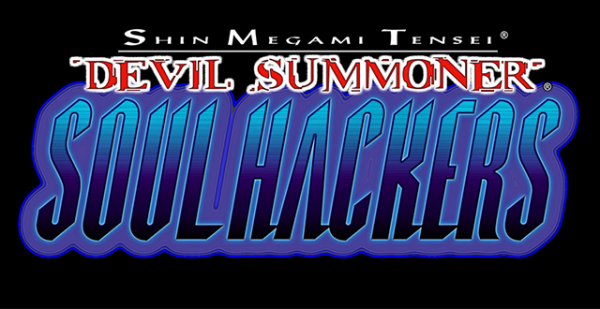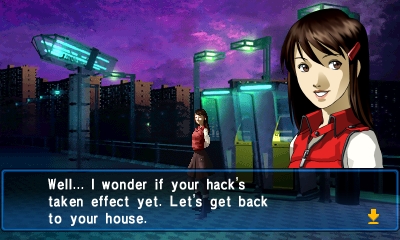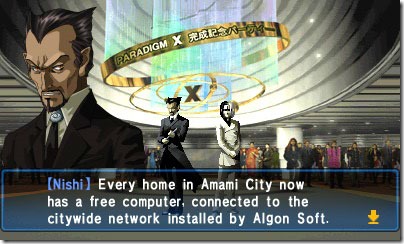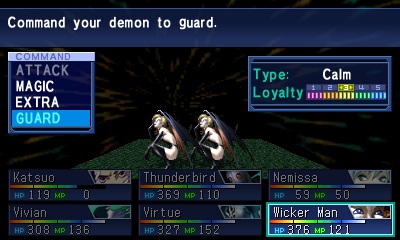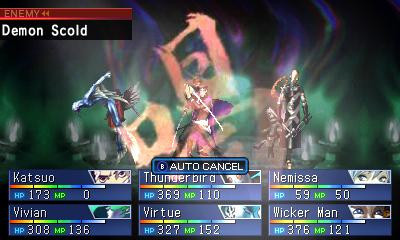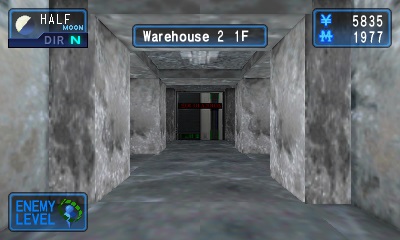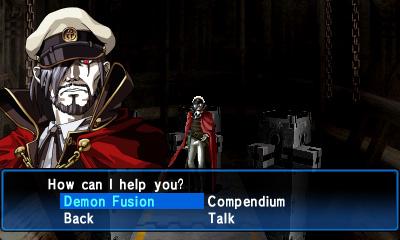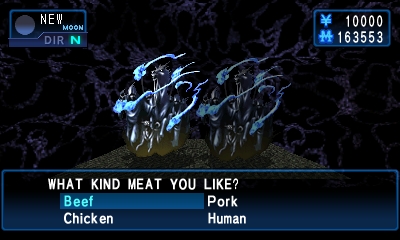Publisher: ATLUS
Developer: Atlus
Medium: Cartridge, Digital Download
Players: 1
Online: N/A
ESRB: M – Mature
Going back in time can be a harrowing event, whether it’s to make sure you don’t kill yourself, or as simple an errand as playing a game on a console that ? to many ? never existed. Fortunately, ATLUS has helped simplify the process by porting one of their games into the here and now, by finally localizing Shin Megami Tensei: Devil Summoner: Soul Hackers for the 3DS.
This way, the past travels to you.
A dozen or so fans managed to find games to play on their Sega Saturn, and some would go so far as to import Japanese titles in order to experience what it was like to have developers support the console. One of those games may have been Soul Hackers, which also found its way onto the Playstation, but still never to America. Now that it’s arrived stateside, players can finally dig into an earlier entry of the SMT series, which appears to be an interesting diversion from typical dungeon crawlers out of any JRPG.
For me, entering the realm of 1997 first-person dungeon crawling in the SMT series was analogous to learning mathematics; being introduced to a new world composed of hard lines and functions which played by the rules of some mysterious underlying system. Eventually, I will understand this process, but for now my only point of reference is a calculator called Persona 3– one that is much more accessible and modern. Even in school where I had an instructor outlining and explaining the ruleset to me, Soul Hackers is very transparent about the concepts at play, and how to appropriate them. That doesn’t mean I wasn’t asleep, but we’ll get back to the gameplay in a pinch.
Taking place in 20XX or something, Soul Hackers is set in a vision of Japan as a cyberpunk metropolis called Amami City. Even people in the game are calling this the city of the future, where everything is connected by broadband, and there’s a hot new MMO in town called Paradigm X. Things really kick off where the story starts, with the main character hacking into the virtual reality world of Paradigm X just to enter the beta and impress a girl, eerily predicting life a decade after Soul Hacker’s original release.
Since you’re naturally a hacker, everything goes off without a hitch. You even summon a phantom voice who warns you that he’s probably a spirit guide and your leader is about to call. It’s probably just early access DLC, but a guy who calls himself Leader does ask you to meet him in a parking structure to hang out with your ragtag hacker buddies, the Spookies. Turns out that he found a lightgun peripheral shaped like a computer that was just sitting on the sidewalk outside the local evil corporate organization in the clutches of a decomposing Indian guy with a few bullet holes in his face. It’s a GUN-Type computer! Doesn’t work until you turn it on, but then it possesses your girlfriend with the soul of a sexy white-haired demon. Might as well see what’s in Paradigm X, now.
With this groundwork, the game is allowed to unravel itself within the structure of dungeon crawling in a first-person perspective, entering random turn-based battles and getting familiar with demons all along the way. The latter of that design being the experimental twist to Soul hackers: demons have feelings too.
ATLUS decided to throw a wrench in the gears of placated JRPG combat by breathing personality into Soul Hackers demon summons, of which the five personality types in the game will determine their behavior in combat scenarios. This will initially be a guessing game for the first few hours, but eventually players are instructed on how to approach and handle certain demons. By the time you’ve been tipped off on key basics in order to recruit them and gain their loyalty, you’ll be getting the hang of the temperamental nature of demons. For instance, dumb demons like to be given a simple ‘Go’ command instead of something direct, and Kind demons are reluctant to use any violent attacks– instead serving the role of your party’s healer.
This dynamic keeps things interesting, as eventually you’ll be giving gifts and playing to your demon’s strengths in order to max out their loyalty for bonus perks such as having them take critical hits for you. Placing an interesting restriction in an RPG is an idea that’s not only ahead of its time, but a subversive take on how to spice up what is normally an exercise in grinding out a party to appeal to the group members’ strengths. Of course, I’m also a sucker for games that challenge their tropes.
Soul Hackers does just that, as well as challenging the player. So often are we used to video games complying to our every input that it’s actually entertaining to be thwarted by your own party members. Just try asking a Kind demon to issue a fire attack and see how far you get.
Similarly, demons must be recruited before they’re part of your squad. This occurs in combat, as either a result of your prowess in battle causing them to submit and offer to party up, or through the option to outright have a Talk. Conversing with a demon depends on several variables, including the moon phase, whether or not your COMP has the right mods installed, and whether or not they’re even interested in discourse. Navigating this abstract dialog sheds some light on demon personalities, from those that are just hungry, to some fickle birds that are touchier than what I remember girls in middle school acting like. Eventually, you’ll learn how to talk to these entities in a way that suits their personality, rather than upsetting them and being attacked without warning.
In this way, Soul Hackers requires the player’s patience. This approach must extend to the entirety of a 16 year-old JRPG, as it already involves a load of trial-and-error in just grasping party management. Beyond that, it’s a port of an early 3D game that’s nearly two decades old, requiring some adaptation to its archaic world navigation, graphical fidelity, and some UI design. Essentially, the 3D world of Paradigm X and game dungeons are composed with a series of empty corridors featuring different tile-sets in their respective areas. This is even more frustrating when encountering an NPC who is available for chatting, because the anticipation of a physical presence is absent, causing you to constantly turn around and hunt down the previous tile you glazed over with a prompt to talk to someone. Coordinating the bottom screen’s top-down map with the 3D space inhabiting the upper screen isn’t exactly riveting gameplay.
Conversely, the overworld is reminiscent of a networking diagram with its tube-like pathways hosting a route for NPCs to flow through. The technological parallel is either intentional or a figure of my imagination, but regardless has served as a nice way of tying design back into the cyberpunk setting.
Allocating criticism for how well a straight port has aged is a losing battle to me. Since there will always exist a divide between purists who want the genuine experience of playing a once-rare entry in their beloved franchise against those who expect some refinement in order to grasp a better idea of what the game was like at the time it released, it’s difficult to evaluate features of the past against today’s equivalent and call it a day. Sometimes there’s a happy medium, and in the case of Soul hackers, the extent of its rebirth has been a resolution and very light cosmetic touch-up to suit the new hardware it’s on.
The only true difference ? besides the addition of new demons and some cutscenes ? is Nemechi, a demon who is a persistent menu option allowing players to collect demons by Streetpass or using Play Coins. This is a fun bonus element, but only bears some convenience and touches briefly on the fact that the game can be adapted to use new technology in some way. It’s also kind of cute.
This game was akin to math for me; a foreign concept that I had to comply with, rather than call the shots. Movement ? for instance ? is controlled strictly through the D-pad, while the Circle Pad serves a few functions which find occasional use, such as panning around the floor map. I also had to learn the hard way that the main character wouldn’t be using any magic and ended up wasting a few stat points on his MP before getting the hint. Not until later will you be given the power to fuse your weapon so that it can benefit from elemental effects.
Fortunately, this also isn’t your typical RPG, and just as say ? algebra ? was actually fun once you got the hang of it, Soul Hackers has much to reward to those who take some time to understand its concepts. The pacing is also surprisingly strong for a JRPG, likely due to the fact that games from its era weren’t interested in wasting our tie with filer nonsense, but rather taking players on a journey. There’s also some wonderful voice acting at play, with a fun batch of characters and fitting soundtrack to carry the audio along. Fans of Shin Megami Tensei games will find their usual staples of fusion and spells in tow, along with another memorable story that rolls along nicely from one place to another.
Soul Hackers may as well be a new game, considering its incredibly limited release. At this rate, it’s almost worth playing just to enjoy a blast from the past that you never had, but also to promote the localization of such titles; this one an ambitious experiment in party management, hinged on the consequences of the relationships with your party rather than the benefits alone. I’d find it hard not to recommend to anyone interested in an RPG with a twist, with the caveat that it may be a tough egg to crack at the start. If nothing else, there’s always the hope that we’d see some return to the philosophies at play in this returned relic.


